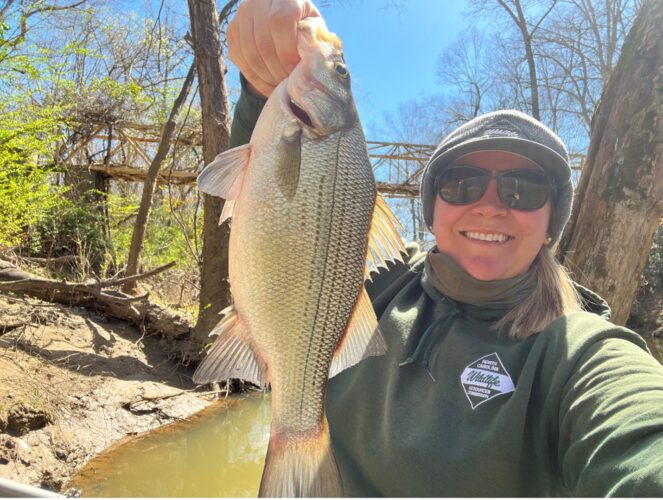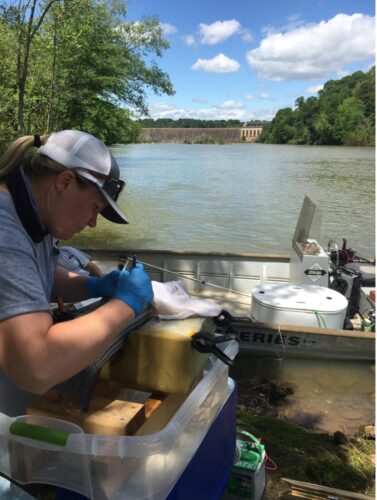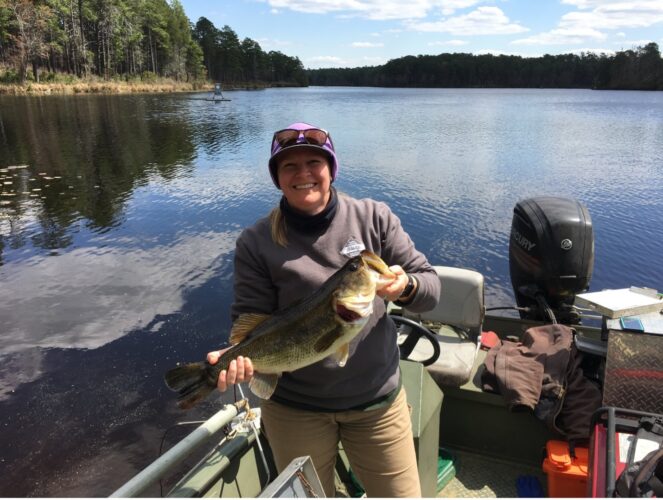Meet your biologist: Joubert & NCWRC’s battle against controlling Norman’s Alabama bass population

Bass Pro Shops REDCREST Presented by Shore Lunch is well underway here on Lake Norman, and as our anglers showcase the fishery, we want to introduce everyone to the biologist who works on the reservoir. Casey Joubert is the District 6 Fisheries Biologist whose region includes Lake Norman. You can meet Casey and multiple members of the North Carolina Wildlife Resource Commission at the REDCREST EXPO this Friday through Sunday, March 10-11.
Steven Bardin: Casey, thank you for joining me for this interview, you have such a cool story about starting out in fisheries – can you share that with out fans?
Casey Joubert: My background actually begins on the very lake the REDCREST 2023 tournament is being held. I grew up in Mooresville and spent a lot of my childhood on Lake Norman. For as long as I can remember I’ve always had a passion for the outdoors and anything involving fish. I received my bachelor’s degree in Marine Biology from University of North Carolina Wilmington and while there I studied Southern Flounder. This got me “hooked” on fisheries research (pun intended). After a brief stint researching fish in Puerto Rico, I returned to North Carolina and completed my master’s in Fisheries, Wildlife, and Conservation Biology with a minor in Toxicology at North Carolina State University. I then moved to Washington state and studied juvenile salmon migration. While I enjoyed working in Washington, I wanted to get back to the South and work on the North Carolina rivers and lakes that I love. I returned to North Carolina in 2019, was hired by the North Carolina Wildlife Resources Commission (NCWRC) and am enjoying my career as a Fisheries Biologist.
SB: How is your team structured and what reservoirs do you cover?
CJ: In North Carolina, management of freshwater fisheries is the responsibility of the Inland Fisheries Division of the NCWRC. Within Inland Fisheries we have nine districts. I’m the District 6 Fisheries Biologist, and myself, as well as Troy Thompson, are responsible for all the public water fisheries in our district. This includes Lake Norman, Mt. Island Lake, Lake Wylie and the Yadkin-Pee Dee chain (from High Rock Lake to the South Carolina border). In total, we have 11 reservoirs that encompass more than 77,000 acres, many small municipality lakes and ponds, and miles of rivers that we manage. While the biologists do a lot of the fish survey work, we have a lot of help from our research coordinators, hatchery personnel, supervisors, wildlife enforcement officers, and many other staff.
SB: For Norman specifically, what are the biggest management challenges facing Lake Norman?
CJ: I would say our biggest challenge at Lake Norman is the invasive Alabama bass (often referred to as spotted bass, but are in fact a different species) and their impact to our native largemouth bass population. Since we first captured Alabama bass back in 2001, we have seen a severe decline in the number of largemouth bass captured and a drastic increase in Alabama bass captured. The decrease in largemouths is likely due to impacts from Alabama bass who appear to be pushing largemouths off of spawning grounds, competing for resources, and generally just being “bullies on the playground.” Unfortunately, we don’t believe – at this point – that there is any way to get rid of Alabama Bass at Lake Norman or the other lakes they are beginning to appear. This is why it’s so important to not move fish.

SB: What can be done to lessen the impact of Alabama bass?
CJ: This is a tough one. Alabama bass are likely here to stay in Lake Norman. The NCWRC passed a regulation that allows for the unlimited harvest of Alabama bass, and we hope that this will allow anglers to put a small dent in the population and possibly give the largemouths a fighting chance. To get back on my soap box for a second – we’re beginning to see Alabama bass spread across N.C. to other areas (over 20 waterbodies) and it’s extremely likely they won’t be good for these other lakes. So… PLEASE DON’T MOVE FISH!
SB: How often do you conduct field sampling and creel surveys?
CJ: Generally, we conduct spring electrofishing surveys for bass on our reservoirs every three years. However, Lake Norman is currently being sampled every year because of an experimental F1 largemouth bass stocking program. Information about this program can be found on our website. Creel surveys are conducted on an as-needed basis and while we don’t have any currently, we hope that if you see a creel clerk in the future, you will participate in our surveys. We also use online surveys and your participation and input matters and will help us make informed management decisions.
SB: Can you tell me a little more about the F1 project at Norman and the genetics of the fish already there?
CJ: The experimental F1 largemouth bass stocking program began at Lake Norman in 2021 after anglers advocated for the stocking of F1 hybrid largemouths. F1 hybrid largemouths are a 50-50 cross between a pure Florida largemouth (Micropterus salmoides floridanus) and a pure Northern largemouth (Micropterus salmoides salmoides). Because our largemouth already have a mix of Northern and Florida genes, we can’t stock pure Northern largemouth or pure Florida largemouth to produce F1 fish, they must be stocked. F1 hybrid largemouth are thought to have higher growth potential because of their hybrid vigor and the NCWRC hopes that this may help increase the number of trophy-size largemouth in the population. We’ll be completing genetics sampling each year through our surveys as well as sampling largemouth bass at tournaments to determine the success of the F1 stocking program.

SB: Are you currently working on any habitat, vegetation, or access projects that we should highlight?
CJ: We have completed many habitat and access projects throughout the district, but a major focus recently has been at Tuckertown Reservoir on the Yadkin-Pee River chain where we have cut-and-cabled trees, planted native vegetation and sunk additional fish attractors to add fish habitat. Across the state, we’re always looking for other projects to improve fish habitat – although this can be challenging in some reservoirs because of the lack of available areas to plant and/or sink attractors. One of the biggest things we can all do is not move invasive aquatic vegetation or fish from waterbody to waterbody. Please check your boats and trailers for aquatic hitchhikers.
SB: What other fisheries should our fans know about within your region? Anywhere that offers a great recreational opportunity or is a hidden gem?
CJ: In addition to our bass fisheries, we have many great angling opportunities. From white bass in the Yadkin River to the Sandhills lakes filled with chunky sunfish, and fun rivers to fish and explore – all within a two-hour drive of Charlotte. One river I especially like to fish is the Uwharrie River which contains white, largemouth, and smallmouth bass, as well as numerous sunfish species. Kayak access is available along the river, and you can easily do a day trip from the Charlotte area. We also stock trout in the winter and channel catfish in the summer at several small municipal lakes and ponds. These can be great opportunities to get kids out fishing. Check out our website for all of these opportunities.
SB: We do genetic testing using a mouth swab on all fish over 7 pounds caught on our tours. Will an angler catch a swab fish during REDCREST, and if so, do you have a guess at the genetic profile we should expect?
CJ: Our last black bass survey was completed in April of 2022, and we collected Alabama and largemouth bass. Of those fish, the largest largemouth we caught was about 4 pounds and the largest Alabama bass was about 3 pounds. So, while it’s not impossible for a swab fish to be caught, it’s unlikely. In Lake Norman, and so far in NC in general, Alabama bass don’t appear to achieve the growth potential that they have in their native range. What we see are many small Alabama bass in the lake and largemouth that have been negatively impacted by them. Our statewide bass genetics study has found that across the state our fish have a mix of Florida and Northern strain largemouth genes and in Lake Norman that mix is about a 35% Florida and 65% Northern split, on average.
SB: What is recreational harvest and tournament pressure like on Norman?
CJ: Lake Norman has many tournaments throughout the year, and they are mostly for black bass. The large size of the reservoir allows anglers to spread out and target various habitats while fishing in these tournaments, so I think in general there’s very little impact to the fishery. I think recreational anglers are beginning to harvest Alabama bass more because the message is being spread that this may help the overall bass fishery in Lake Norman. While we certainly encourage harvest of Alabama bass, we know that this will never lead to them being extirpated from the lake, but it may relieve some pressure on the largemouth bass and open up food resources, hopefully leading to both larger Alabama bass and more robust largemouth bass.
SB: How can local anglers reach out to you about Alabama bass or other fisheries questions?
CJ: My contact information is:
(910)-729-0872
To report wildlife violations, call: (800)-662-7137